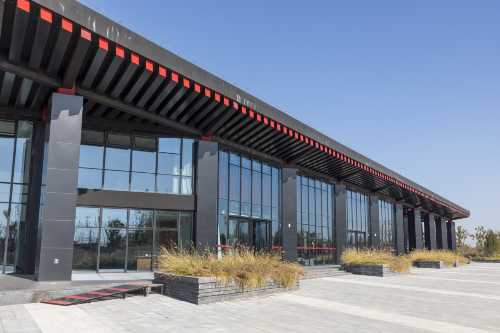Popular Trip Moments
[Anyang City, Henan Province] Yuan Lin Road Trip. | Passing Through Your City - Anyang | Anyang | Two Jinshi Scholars from One Family: The Mashi Manor. | Great Places to Visit During the Spring Festival: 6-Day Itinerary in Anyang | Isn't the Cao Cao Mausoleum Museum a must-visit for history lovers? | A tour of the historical manor: visiting the cultural relics of the Ma family | Explore the Gaoling Tomb in Anyang | Follow in the footsteps of Cao Cao. | Anyang Ma Family Manor | A model of a feudal bureaucratic mansion in Central China!!! | Anyang Cao Cao Gaoling Museum, the burial place of a great hero. | Wei Wu's whip is a thousand years old, and this niche is not for you to understand. | A lifetime of battles, yet never crowned emperor---Cao Cao's 'Gaoling' | The Majestic Mausoleum, the Resting Place of Heroes - Visiting the Cao Cao Mausoleum Site Museum | The only unique pagoda in the country | 2024 Cultural Summer Tour (VI): China's First Chinese Pagoda - Xiuding Temple Pagoda | Xiuding Temple | The 'Three Lives Pagoda'—the Xiu Ding Temple Pagoda | A single brick from the Xiuding Temple Pagoda can buy a house in Beijing | A Mausoleum of a Legendary Warlord – The Cao Cao Gaoling Site in Anyang | The Legacy of Northern Qi, the Treasure of Henan: The Exploration of Xiuding Temple Pagoda | The number one tower in the world! What exactly makes it so? | The cultural relics unearthed from the tomb of Cao Cao are so austere that they are jaw-dropping | Beautiful brick carvings, as if created by nature | Xiuding Temple Pagoda in Anyang, Henan | Understand the real King Wei Wu in Gaoling | Anyang Xiuding Temple Pagoda / A severely underestimated Buddhist pagoda!
Recommended Attractions at Popular Destinations
Bangkok attraction near me | Manila attraction near me | Tokyo attraction near me | Taipei attraction near me | Hong Kong attraction near me | Seoul attraction near me | Kuala Lumpur attraction near me | Los Angeles attraction near me | Shanghai attraction near me | New York attraction near me | Shenzhen attraction near me | Osaka attraction near me | Singapore attraction near me | London attraction near me | Guangzhou attraction near me | San Francisco attraction near me | Beijing attraction near me | Macau attraction near me | Bali attraction near me | Jakarta attraction near me | Paris attraction near me | Ho Chi Minh City attraction near me | Istanbul attraction near me | Phuket attraction near me | Chicago attraction near me | Seattle attraction near me | Toronto attraction near me | Orlando attraction near me | Cebu attraction near me | Chiang Mai attraction near me
Popular Attractions
View of Alefkandra (Little Venice) | Ain Dubai | Dameisha Coastal Park | Erhai Lake | Universal Beijing Resort | Kuala Lumpur Tower | Shanghai Maglev Train | Sentosa | Independence Square | Shanghai Wild Animal Park | Yas Waterworld | Jimbaran Beach | Safari World Bangkok | Island Of Legends | Laufhaus Kleeblatt | SM MOA Eye | Canal City Hakata | KidZania Kuala Lumpur | ASPA Contemporary, Galería de arte | Antigo Moinho Melatti | Pilgerhütte auf der 3. Etappe von dem "Der originale Kinzigtäler Jakobusweg" | Bradshaw Ranch | Liberty Baptist Church | Golden Dragon Beach | Keman Spielcasino Ost | Sydowsee | Kuopio Automobile Museum | D+N bench | Safari Park Shenzhen | Dubai Helicopter Tour(From Dubai Police Academy)
Popular Restaurants in Anyang County
MEI GUO JIA ZHOU NIU ROU MIAN DA WANG | 晓云擀面皮店(马氏庄园店) | 安阳东服务区-餐厅 | 辛村香辣虾重庆鸡公煲火锅店 | 日日鲜蛋糕房 | 麦香园(白璧店) | 派乐汉堡·炸鸡(二中店) | MEI GUI GU GAO ZHUANG DIAN | 涮魁平价火锅 | 君香斋生态餐厅 | 千里香馄饨 | 笨鸭火锅大骨头 | 甲添虾营养火锅(曲沟店) | 晋道削面川菜家常菜(建业桂园店) | 宴奴饺子手擀面 | 真鱿味 | 红兜兜擀面皮 | 姐弟俩土豆粉 | 沪上阿姨(后营师范学院店) | 六合宴宾 | 刘一锅 | 棉宝生态农庄 | HAO YUN LAI DAN GAO | 四雷黄记熟肉小菜 | 一品鲜火锅店 | 陈氏凉皮老店 | 文新赵卫彬片片鱼(伦掌文新店) | 陪伴蛋糕甜品 | 重庆德荘火锅 | 福满楼
Popular Ranked Lists
Top 3 Best Things to Do in Yanji | Top 10 Local Restaurants in Kathmandu | Popular Premium Hotels Near Shelby County | Popular Luxury Hotels in Ramatuelle | Popular Must-Visit Restaurants in Hanoi | Popular Premium Hotels Near Memphis | Popular Best Things to Do in Wuhai | Popular Best Things to Do in Qinzhou | Popular Premium Hotels Near Bentonville | Popular Must-Visit Restaurants in Taipei | Top 5 Best Things to Do in Huaihua | Top 10 Local Restaurants in Canberra | Popular Best Things to Do in Xinchang | Popular Best Things to Do in Jiamusi | Popular Premium Hotels in Midland | Top 10 Local Restaurants in Brussels | Top 3 Best Things to Do in Zaozhuang | Popular Best Things to Do in Meizhou | Top 4 Best Things to Do in Wenling | Top 5 Local Restaurants in Ulaanbaatar | Popular Luxury Hotels in Versailles | Top 7 Local Restaurants in Nadi | Popular Premium Hotels in Taunggyi | Popular Premium Hotels in Pipa | Popular Premium Hotels Near Samosdelka | Popular Best Things to Do in Luanping | Popular Luxury Hotels in Yvelines | Popular Must-Visit Restaurants in Bali | Popular Premium Hotels in Saarbruecken | Popular Must-Visit Restaurants in Osaka
Payment Methods
Our Partners
Copyright © 2025 Trip.com Travel Singapore Pte. Ltd. All rights reserved
Site Operator: Trip.com Travel Singapore Pte. Ltd.
Site Operator: Trip.com Travel Singapore Pte. Ltd.





























